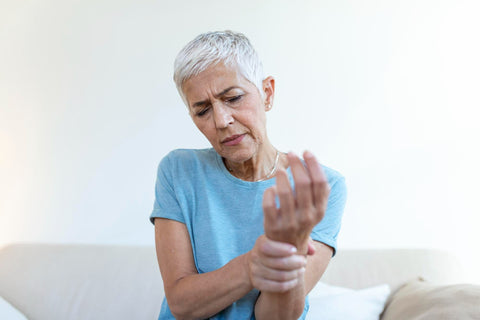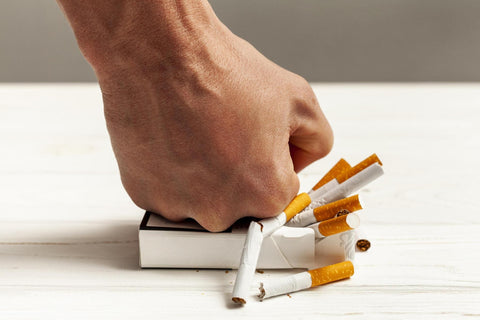Osteoarthritis is the most common type of arthritis in the UK with an estimated 9 million people affected by the condition.
Joints consist of two or more bones that meat together. In order to prevent friction and damage the ends of both opposite hard bones are covered with softer material made of cartilage. In addition, to make movements smoother and to prevent bones and cartilages from touching each other, the space between both cartilages that cover two separate bones is filled with a special substance called synovial fluid, which in a healthy joint works as a lubricant for the joint. In osteoarthritis, however, due to various factors this shock absorber has been damaged causing inflammation and pain.
Physiological Cause
We know now that condition of the joint cartilage depends on health and activity of chondrocytes (the only cells found in healthy cartilage) which produce and maintain the cartilaginous matrix that consists mainly of collagen and proteoglycans. It is believed that degeneration of cartilage in osteoarthritis involves two phases: a biosynthetic phase, during which chondrocytes desperately try to repair the damaged matrix; and a degradative phase, in which the activity of enzymes produced by the chondrocytes digests the matrix, matrix synthesis (regeneration) is inhibited, and the consequent erosion of the cartilage is accelerated. It means that at some point the biosynthetic anabolic activity is unable to keep pace with the degradative catabolic activity, and degeneration of the tissue results. The question, however, is why the cartilage retains function for many years, and then begins to erode rapidly.

Lifestyle Causes
Unhealthy lifestyle and diet
It has been discovered that osteoarthritis involves not only the cartilage degeneration but the entire joint area, including the underlying bones and synovial membrane. The cells in all these three tissues start degenerating for a reason. We have been brainwashed with the false idea that osteoarthritis is just a wear and tear problem involving only cartilage which slowly progresses with age. Obviously, this idea is not true as there are many elderly people who enjoy perfectly functional joints and are free from osteoarthritis. It is, therefore, not the age but the insufficient self-repair caused by bad diet, deficiency of vitamins, minerals and antioxidants, poor blood circulation and clogged capillaries in the joints, excess body weight, lack of exercise and sunlight, loss of strength in the muscles supporting joints; impairment of peripheral nerves, and other factors that make joints unable to regenerate the damaged cartilage.
Clogged capillaries and poor blood circulation in joints
The joint cartilage and articulating bone should regularly receive nutrients and oxygen from both capillaries and joint capsule fluid. The main factor in the development of osteoarthritis is especially the poor blood circulation in capillaries (the smallest blood vessels) which are responsible for delivering nutrients and oxygen to the joints. Chronic high blood sugar levels, bad diet (high in refined foods, sugar, pro-inflammatory fats and cholesterol), as well as regular intake of stimulants and animal foods damage and clog capillaries. As a result, the blood can’t flow through those tiny blood vessels causing that oxygen and nutrients are not delivered to the joint tissue leading to gradual damage. Poor oxygenation of the cells found in joints interferes with efficient repair and regeneration of joints leading to degeneration and increased pain which progresses with age.
Too much lactic acid from excess glucose
A group of researchers from the University of Surrey, who carefully reviewed all the research and scientific data dealing with osteoarthritis, provided another proof concerning the true causes of this condition. After reading their conclusion it becomes clear that sedentary lifestyle (lack of exercise) and regular consumption of refined foods (high in sugar and bad fat), make the cells in our body (including joints) unable to generate enough energy to maintain proper metabolism (detoxification and regeneration). As a result cells make too much glucose in order to cope with this energy short-fall. Unfortunately, the unused glucose is converted into lactic acid, which can’t be efficiently removed and triggers inflammation in joint cartilage, gradually leading to osteoarthritis.
Calcium deposits
Many people with osteoarthritis have calcium pyrophosphate crystals deposited in their affected joint cartilage, especially in the knee. This inorganic calcium accumulation is caused by drinking hard water high in inorganic calcium, calcium in milk and dairy, calcium carbonate in supplements and fortified foods. This calcification process is made worse by the widespread vitamin K2 deficiency as this vitamin makes sure that calcium is deposited only in bones and not in the cartilage, blood vessels or organs.
Boron deficiency
There are reasons to believe that one of the key causes of osteoarthritis is deficiency of boron. In his research paper titled “Essentiality of boron for healthy bones and joints”, Prof R. E. Newnham wrote that “in areas of the world where boron intakes are 1.0 mg or less/day the incidence of arthritis ranges from 20 to 70%, whereas in areas where boron intakes are 3 to 10 mg, the incidence of arthritis ranges from 0 to 10%. In addition, there is an experimental evidence that rats with induced arthritis benefit from orally administered boron. Also in a double-blind placebo-boron supplementation trial with 20 subjects with osteoarthritis, a significant favourable response to a 6 mg boron/day supplement was obtained; 50% of subjects receiving the supplement improved compared to only 10% receiving the placebo.” (https://pubmed.ncbi.nlm.nih.gov/7889887/)
How to Improve Joint Health
Many people suffering from osteoarthritis believe that the problem is just a matter of bad luck or ageing. The truth is that it is possible to prevent osteoarthritis and improve joint health by properly addressing the above causes and implementing the listed below principles.
Nutritional and Lifestyle Recommendations
-
Proper internal hydration of the body (including joints and bones) through drinking properly filtered water (8-10 glasses daily) is crucial.
-
Improve blood circulation through regular energetic physical activity, water treatments (alternative hot and cold showers), unrefined plant-based diet, and herbal extracts (especially Ginkgo biloba). Even if we manage to supply the body with all the nutrients, yet without proper blood circulation and clean flexible capillaries, the body may still fail to reverse the damage as capillaries won’t be able to provide oxygen, nutrients, phytochemicals and antioxidants to the synovial fluid and cartilage.
-
People with osteoarthritis can benefit from positive dietary changes. A 2015 study found that people on a whole-food, plant-based diet significantly decreased their osteoarthritis pain—in just 14 days. Another study found that a high-fibre plant-based diet could lower the risk of osteoarthritis by up to 60%.
-
Often eat fresh celery salads, add it to smoothies, and drink fresh celery juice. Researchers have identified over a dozen different types of compounds and antioxidants that are responsible for the benefits of celery. These include phenolic acids and flavanols (such as quercetin). Due to its detoxifying and antiinflammatory potential, celery may ease various health problems associated with inflammation, including arthritis.
-
Consume fresh grapefruits and especially fresh pineapples because pineapples contain bromelain, an enzyme that helps to fight inflammation. It must be fresh pineapple because canning, freezing and processing it destroy the enzyme.
-
Some arthritis sufferers recommend avoiding nightshades (white potatoes, tomatoes, eggplant and peppers) because these foods are high in solanine which may cause worsening of symptoms. According to N. F. Childers, PhD, and M.S. Margoles, MD “Rigid omission of Solanaceae, with other minor diet adjustments, has resulted in positive to marked improvement in arthritis… Solanaceae (nightshades) are an important causative factor in arthritis in sensitive people.” It means that avoiding nightshades may not be beneficial for every person suffering from arthritis but only those who are “sensitive”. In order to find out if you are sensitive you need to avoid nightshades for 3 months.
-
Arthritis appears to be more prevalent in populations with high meat and dairy consumption. Diet should consist of most healthy foods including especially raw fresh vegetable juices, super greens (chlorella, spirulina, barley grass, alfalfa, and wheat grass), and sprouts. A study published in the February, 2003 issue of Annals of Rheumatic Diseases confirmed that a Mediterranean diet which is high in whole plant foods including fruits, vegetables, legumes, and cold-pressed olive oil helps arthritis sufferers.
-
Drink raw fresh vegetable juices (carrots, celery, kale, broccoli, beetroot, etc.): 2-3 times a day 1 glass 30 min before meals.
-
Eat foods rich in resveratrol (red grapes, cranberries, and blueberries) as it helps slow down the progress of arthritis. Scientists at Rush Medical University showed that resveratrol blocks the enzyme that is responsible for tissue degeneration.
-
Avoid proinflammatory omega-6 fatty acids fats including popular refined oils (sunflower oil, corn oil, soya oil, vegetable oil, etc.) and margarines. Instead use raw organic coconut oil and cold-pressed olive oil.
-
Avoid dairy products (especially cheese), gluten, processed products, foods high in nitrites (meats), white flour products, white pasta, refined rice, artificial sweeteners, any foods containing high fructose high-glucose syrup, and refined sugar as all of them can exacerbate the inflammation and pain.
Nutritional Supplements
- Rose Hip from Rosa canina (dog rose) has been shown to help ease arthritis when taken on a daily basis. It has anti-inflammatory properties and may block the activation of proteins in cartilage cells that can lead to unhealthy degradation of joint tissue. The key active ingredient in Rose hip which is responsible for the beneficial effect, is a fat-soluble galactolipid compound called GOPO. The results of studies carried out at Frederiksberg University in Copenhagen and published in the Open Journal of Rheumatology and Autoimmune Disease claim that “GOPO has been shown anti-inflammatory and chondroprotective activity, helping to protect and repair joint cartilage even at low concentrations.”
- Glucosamine hydrochloride. The body uses glucosamine to form the chemicals it needs to repair cartilage, tendons, ligaments, and synovial fluid (the naturally occurring fluid that bathes the spinal joints). Should you use glucosamine hydrochloride or glucosamine sulphate? The active ingredient in any glucosamine product is only the glucosamine element, and the hydrochloride or sulphate acid salt is only a delivery vehicle. Therefore, both forms are recommended.
- Hyaluronic acid supplements have been shown to help improve joint health.
- Take nutritional supplements containing MSM (sulphur) and consume foods rich in sulphur (especially onion, garlic, cabbages, and asparagus) as it is essential to rebuild bone, cartilage and connective tissue.
- Turmeric and its key active ingredient Curcumin may help ease pain and inflammation. Colitti (2012) found that oral delivery of curcumin in patients with osteoarthritis leads to decreased production of various inflammatory factors. In another study, 40 subjects with mild to moderate knee pain demonstrated reduction in inflammation and pain as a result of ingesting turmeric (Kuptniratsaikul et al., 2014).
- Vitamin K2 may also play a very important role in joint health. When body tissues are damaged due to oxidative stress the body responds by triggering inflammation which results in calcium accumulation in the damaged tissues which builds up a plaque in blood vessels and also creates degenerative bone spurs in joints. Vitamin K2 (MK7) prevents calcium from being deposited in joints. Please keep in mind that it is Vitamin K2 (either MK7 or MK4) but not Vitamin K1 that helps prevent and recover from arthritis.
- Boron is one of the most important supplements to benefit joint health. It was found that in countries with low levels of boron in the soil, arthritis rates are about 70%. The daily boron intake in these countries is less than 1 mg/day. For instance, the Indians are estimated to have an arthritis rate of about 40% as they eat rice grown with fertilizer (soil low in boron) while the native Fijians with an estimated arthritis rate of 10% eat mainly starchy root vegetables grown privately without fertilizer (soil significantly higher in boron).
- Deficiency of Magnesium and Vitamin B6 in animals contribute to arthritis. Take pure Magnesium citrate powder (free from additives): 200mg 2 to 3 times daily. Also remember to take magnesium whenever you use vitamin D supplements as vitamin D leads to magnesium deficiency. The more vitamin D you take the higher doses of magnesium you need because magnesium is used in kidneys to convert inactive vitamin D3 into an active D4 form.
- Omega 3 may help to ease inflammation and pain caused by chronic conditions such as osteoarthritis.
- Research shows that Bromelain found in fresh pineapples and supplements reduces levels of prostaglandins, which are hormones that induce inflammation.
Hydrotherapy
- Water treatments should be performed every day, especially alternative heat and ice therapy. It is effective in easing pain, improving blood circulation, elimination of toxins, and will stimulate regeneration of the damaged cartilage. Start with heat first (hot water bottle, electric heating pad, hot shower, hot towel compress, or hot bath) and after about 3 minutes, when the treated area is warm enough, apply an ice pack or any very cold treatment (cold shower, cold compress, etc.) for about 2-3. Then alternate the hot and cold application back and forth 5-7 times in a row.
- There are individuals who claim that using Emu oil helped them ease the pain.
Sources
- https://p.widencdn.net/fhiuem/Foods-and-Arthritis
- https://www.pcrm.org/news/health-nutrition/high-fiber-diet-lowers-risk-arthritis
- http://noarthritis.com/research.htm
- http://www.greenmedinfo.com/disease/arthritis
- Dai Z, Niu J, Zhang Y, Jacques P, Felson DT. Dietary intake of fibre and risk of knee osteoarthritis in two US prospective cohorts. Ann Rheum Dis. Published online May 23, 2017.
- Runhaar J, Deroisy R, van Middelkoop M, et al. The role of diet and exercise and of glucosamine sulfate in the prevention of knee osteoarthritis: Further results from the Prevention of knee Osteoarthritis in Overweight Females (PROOF) study. Semin Arthritis Rheum. 2016;45 (4 Suppl): S42-8.
- Yves Henrotin, PhD,1 Mariane Mathy, PhD,2 Christelle Sanchez, PhD,2 and Cecile Lambert, PhD2. Chondroitin Sulfate in the Treatment of Osteoarthritis: From in Vitro Studies to Clinical Recommendations. Ther Adv Musculoskelet Dis. 2010 Dec; 2(6): 335–348.
- Funk JL, Oyarzo JN, Frye JB, Chen G, Lantz RC, Jolad SD, Sólyom AM, Timmermann BN. Turmeric extracts containing curcuminoids prevent experimental rheumatoid arthritis. J Nat Prod. 2006 Mar; 69(3):351-5. PubMed PMID: 16562833; PubMed Central PMCID: PMC2533857.
- Images: Wrist pain photo created by stefamerpik - www.freepik.com
- Body illustration vector created by brgfx - www.freepik.com
Any information or product suggested on this website is not intended to diagnose, treat, cure or prevent any medical condition. Never disregard medical advice or delay in seeking it because of something you have read on this website. Consult your primary healthcare physician before using any supplements or making any changes to your regime.




